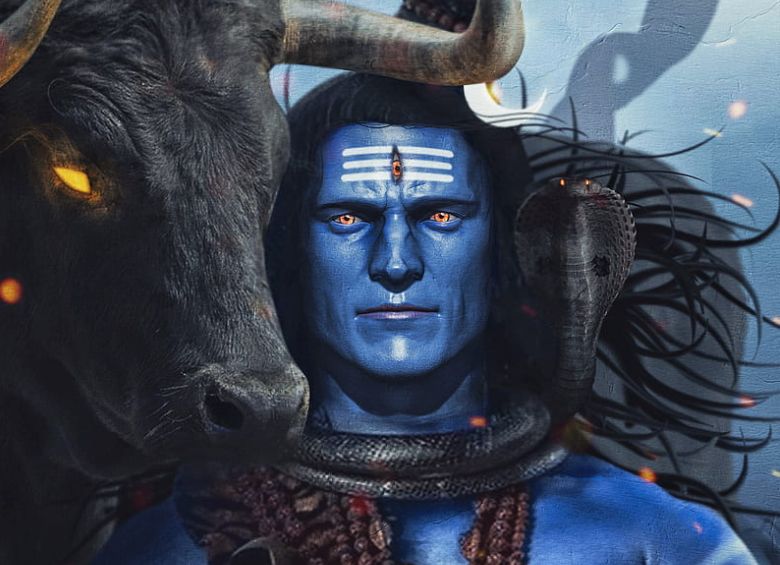Related Articles
Lord Shiva is a prominent deity in Hinduism and is one of the three main gods in the Hindu pantheon, along with Brahma and Vishnu. He is also known by several other names such as Mahadeva, Maheshwara, Nataraja, and Rudra.
According to Hindu mythology, Lord Shiva is considered the destroyer or transformer of the universe, and his role is to pave the way for the creation of new things.
He is often depicted with a third eye on his forehead, a crescent moon on his head, and a serpent around his neck. He is also associated with the river Ganges, which is believed to have originated from his hair.
Lord Shiva is also considered the god of meditation and yoga, and many people worship him as a way to attain inner peace, strength, and knowledge. He is often depicted in a meditative pose, and his teachings are said to emphasize the importance of self-realization and the attainment of higher consciousness. In Hinduism, Lord Shiva is widely regarded as one of the most important and powerful deities.
The word Shiva is used as an adjective in the Rig Veda, as an epithet for several Rigvedic deities, including Rudra. The term Shiva also connotes “liberation, final emancipation” and “the auspicious one”; this adjectival usage is addressed to many deities in Vedic literature. The term evolved from the Vedic Rudra-Shiva to the noun Shiva in the Epics and the Puranas, as an auspicious deity who is the “creator, reproducer and dissolver”.
Different Facets of Lord Shiva

Lord Shiva is a multi-faceted deity in Hinduism, and he is often depicted and worshipped in different forms and aspects. Here are some of the different facets of Shiva:
Nataraja: Nataraja is the dancing form of Lord Shiva, and he is often depicted in this form with four arms and a leg lifted in a dance pose. The Nataraja form symbolizes the cyclical nature of life and the importance of creation, destruction, and preservation.
Ardhanarishvara: Ardhanarishvara is the androgynous form of Lord Shiva, which represents the balance and harmony of male and female energies. In this form, Shiva is depicted as half-man and half-woman, with one side of his body representing the masculine and the other side representing the feminine.
Mahadeva: Mahadeva is a Sanskrit term that means “Great God,” and it is one of the most common names used to refer to Lord Shiva. As Mahadeva, he is often depicted as a powerful and majestic figure, with multiple arms, weapons, and a third eye on his forehead.
Pashupati: Pashupati is the lord of the animals, and in this form, Lord Shiva is depicted as a benevolent and caring figure, who protects and nurtures all living beings.
Bhairava: Bhairava is the fierce form of Lord Shiva, and he is often depicted as a terrifying figure with matted hair, a third eye, and a necklace made of human skulls. Bhairava represents the destructive aspect of Lord Shiva, and is often associated with death and transformation.
Shiva Linga: The Shiva Linga is a phallic symbol that represents Lord Shiva’s creative energy and the male principle of the universe. The Shiva Linga is a common object of worship in Hinduism, and it is often worshipped as a physical representation of Lord Shiva’s power and presence.
These are just a few of the many different facets of Lord Shiva, and they represent the different aspects of his character and his role in the universe. Each form of Lord Shiva has its own symbolism and significance, and people often worship Lord Shiva in the form that resonates with them the most.
Why Shiva has a Blue Throat?

In Hindu mythology, Lord Shiva is known as Neelakantha, which means “the blue-throated one.” According to legend, during the churning of the ocean by the gods and demons to obtain the elixir of immortality, a deadly poison known as Halahala emerged from the ocean.
The poison was so toxic that it threatened to destroy the entire universe, and both the gods and the demons were afraid to touch it. In order to save the world from destruction, Lord Shiva drank the poison, and as it passed through his throat, it turned his throat blue, hence the name “Neelakantha.”
To prevent the poison from spreading to the rest of his body, Lord Shiva stopped it in his throat, and it is said that he held the poison in his throat for a thousand years, until it was neutralized by his divine powers. The blue color of his throat is thus seen as a symbol of Lord Shiva’s sacrifice and willingness to take on the suffering of the world in order to protect it.
The blue throat of Lord Shiva is also seen as a symbol of his connection to the spiritual world, and his ability to absorb negative energy and transform it into positive energy. It is said that by meditating on the blue throat of Lord Shiva, one can overcome negative emotions and attain a higher state of consciousness.
Why is Shiva the Destroyer?

Lord Shiva is known as the destroyer or transformer of the universe. While this might sound like a negative or destructive aspect of Lord Shiva, it actually has a deeper meaning and significance.
The universe is cyclical in nature, and everything in it is subject to the laws of birth, growth, decay, and death. In order for new things to be created, old things must be destroyed or transformed. Lord Shiva represents the force of destruction or transformation, which is necessary for the continuation and evolution of the universe.
In this sense, Lord Shiva is not seen as a negative or destructive force, but rather as a powerful and necessary aspect of the divine. He is often depicted with a third eye on his forehead, which represents his ability to see beyond the physical realm and into the spiritual world. This ability to see beyond the physical world allows him to understand the true nature of existence, and to facilitate the process of transformation and evolution that is necessary for the universe to continue.
In addition to his role as the destroyer, Lord Shiva is also associated with the qualities of compassion, wisdom, and creativity. He is often depicted in a meditative pose, and his teachings are said to emphasize the importance of self-realization and the attainment of a higher consciousness. As such, Lord Shiva is seen as a powerful and benevolent deity who plays a key role in the ongoing cycle of birth, growth, decay, and rebirth that characterizes the universe.
Mahashivratri - The Great Night of Lord Shiva

Mahashivratri is one of the most important festivals in Hinduism, and it is dedicated to the worship of Lord Shiva. The festival falls on the 14th night of the Hindu month of Phalguna or Maagh, which usually corresponds to February or March in the Gregorian calendar.
The word “Mahashivratri” means “the great night of Lord Shiva,” and it is believed that on this day, Lord Shiva performed the Tandava Nritya, a celestial dance that represents the cycle of creation, destruction, and preservation. The festival is celebrated with great devotion and fervor by Hindus all over the world, and it is marked by fasting, prayer, and the chanting of hymns and mantras in praise of Lord Shiva.
On Mahashivratri, devotees often observe a fast and stay up all night, singing devotional songs and offering prayers to Lord Shiva. Many people also visit Shiva temples and perform special rituals and offerings, such as bathing the Shiva Linga with milk, honey, and water. The festival is also associated with the consumption of bhang, a preparation made from the leaves of the cannabis plant, which is believed to be a favorite of Lord Shiva.
Mahashivratri is considered to be a particularly auspicious day for spiritual seekers, and it is believed that by observing the rituals and practices associated with the festival, one can attain the blessings and grace of Lord Shiva, and move closer to the goal of self-realization and enlightenment.
How Lord Shiv Impact our Lives?

Lord Shiva is one of the most revered deities in Hinduism, and his teachings and qualities are considered to be of great significance in the spiritual and cultural traditions of India. Here are a few ways in which Lord Shiva’s impact can be seen in our lives:
He symbolizes inner strength and self-control: Lord Shiva is often depicted as a yogi who is able to control his thoughts, emotions, and physical senses through meditation and other spiritual practices. His teachings emphasize the importance of cultivating inner strength and self-control, which are essential for leading a peaceful and fulfilling life.
He represents the power of transformation: Lord Shiva is known as the destroyer and transformer of the universe, and his ability to turn negative energy into positive energy is seen as a powerful example for all of us to follow. His teachings emphasize the importance of embracing change and transformation, and of using our experiences and challenges to grow and evolve.
He is associated with creativity and the arts: Lord Shiva is often depicted as a patron of the arts, and his teachings emphasize the importance of creativity and self-expression. His association with music, dance, and other forms of artistic expression inspires us to cultivate our own creative talents and to appreciate the beauty and diversity of the world around us.
He symbolizes the cycle of life and death: Lord Shiva’s role as the destroyer and transformer of the universe reminds us of the impermanence of all things, and of the need to embrace the cycles of life and death that are an essential part of our existence. His teachings emphasize the importance of letting go of attachment and embracing the present moment, as we never know what the future may bring.
Overall, Lord Shiva’s teachings and qualities can have a profound impact on our lives, inspiring us to cultivate inner strength, embrace change, appreciate the beauty and diversity of the world around us, and find meaning and purpose in our existence.
 Saptarishis Astrology Magazine Into Creating Astrologers
Saptarishis Astrology Magazine Into Creating Astrologers







One comment
Pingback: Saptarishis Astrology (saptrishiastros) | Pearltrees